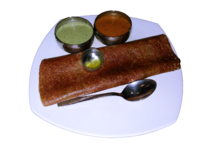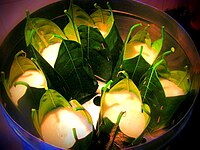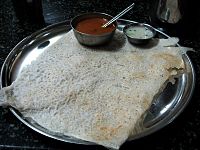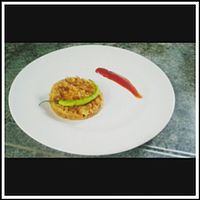Udupi cuisine
| This article is part of the series on |
| Indian cuisine |
|---|
 |
| Part of Culture of Karnataka |
 |
This article has multiple issues. Please help improve it or discuss these issues on the talk page. (Learn how and when to remove these template messages)
|
Udupi cuisine is a
Some of Udupi cuisine is
Udupi cuisine has its origin in the
Udupi cuisine comprises dishes made primarily from grains, beans, vegetables, and fruits. The variety and range of dishes is wide, and a hallmark of the cuisine involves the use of locally available ingredients. The famous dosa (thick crisp pancakes, plain or masala when stuffed with potatoes) is said[by whom?] to have originated from this cuisine.
Following the tradition of chaaturmasa vrata, which is a restriction of certain food ingredients in a certain period or season, may have led to the innovation of a variety of dishes in Udupi cuisine. Pumpkins and gourds are the main ingredients in sambar, a stew prepared with ground coconut and coconut oil as its base.[citation needed]
The ubiquitous Indian dish
Typical dishes
Full-course Udupi meals
The full course Udupi meal is served on a
- Abbhigara or Ghee
- Salt
- Pickle
- Kosambari (seasoned salad made from split Bengal gram or pea)
- Bajji
- Chutney
- Ajethna
- Spiced rice (chitranna)
- Happalla
- Steamed rice
- Saaru (a spicy watery soup)
- Menaskai
- Koddel
- Majjige huli, Puli kajippu
- Sweets like Kesari bhath, Jalebi
- Fried items like bonda, chakli, vada
- Paramanna or Kheer (pudding) or Payasa
- Buttermilk/curd
Depending upon the occasion, individual taste, and money, each dish may be made from different ingredients.
Popular dishes in Udupi cuisine
- Buns (Mangaluru Buns), a sweet dish fried out of Maida flour and Banana
- neer dose, uppu huli kara dosa
- Gashi or Ghasi (thick gravy-like dish made by use of peas or pulses with coconut)
- Kadubu
- Kashi halva from musk pumpkin, jackfruit, banana, and bottle gourd
- Kodhel or sambar (sambar made from lentil, coconut and vegetable of choice)
- Kosambari (salads of green gram or Bengal gram lentils, seasoned)
- Mangalore bajji or Golibaje[5]
- Menaskai (especially made of Amtekai or ambade)
- Patrode (colacasia leaves dipped in batter and steamed cooked)
- Putnis
- Pelakai appa (fried dumplings made from jackfruit)
- Pelakai Gatti/gidde
- Pelakai halwa (jackfruit halwa)
- Puddings or parammanna or payasaor kheer
- Saaru or rasam (rasam made from lentil and tomato)
- Sajjige and bajil (beaten rice)
- Sweet dishes like sajjige, maddi,manni, kaai holige, undae (laddu)
- Uddinahittu (urad flour or potato mashed mixed in curd and seasoned)
Overview of Udupi cuisine
| Food item | Ingredients | Preparation | Image | Remarks |
|---|---|---|---|---|
Masala Dosa
|
Rice, Lentils (deskinned black gram) | Dosa with ghee; stuffed with cooked potatoes | 
|
Invented by Udupi hotels [citation needed] |
Pathrode
|
Colacasia leaves, Rice | Spiced rice flour applied to colacasia leaves, rolled and steamed | 
|
Popular during the rainy season |
| Kotte kadubu | Rice, Lentils (deskinned black gram) | Steamed batter in jackfruit leaves | 
|
Moday is a similar preparation steamed in screw pine leaves. |
| neer dosa | Rice | Dosa prepared from rice flour | 
|
|
| Undla kai | Rice | Steamed rice balls | Rainy season dish | |
| Shyavige or Othu shyavige | Rice, Grated coconut | Rice based vermicelli | ||
| Goli Baje | Maida
|
Deep fried balls of batter | 
|
Also called Mangalore bajji |
| Halasina Kadabu | Rice, Jackfruit | Steamed ground rice and jackfruit | 
|
|
| Thambuli | Coconut, buttermilk, brahmi leaf | Enjoyed as a side-dish |
Udupi restaurants
Udupi or Udipi restaurants serving Udupi cuisine can be found all over India and many parts of the world. In the past, these restaurants were run by cooks and priests trained at Krishna matha in Udupi.[6] With rising popularity, many others have entered this business claiming to serve authentic Udupi cuisine.[7] Most Udupi restaurants are family run, with ownership passing among kith and kin of the original owner.[8] Udupi restaurants have undergone many changes in their menu in recent times, adapting to changing economic structure and social statuses in India. They have included vegetarian delicacies from other Indian cuisines.[9]
The first major Udupi restaurant owner,
In 1923, a major flood devastated Udupi and caused mass migration of male workers and professionals to large cities. This led to a rising demand for low-cost public eating places.[10] Several prominent Udupi restaurants such as Dasaprakash in Mysore, Udupi Sri Krishna Bhavan and Mavalli Tiffin Rooms in Bangalore, were set up to cater to this demand.[10] These restaurants were vegetarian, employed OBCs and upper-caste Hindus from Udupi, and initially, segregated seating spaces along caste lines.[10]
Mumbai, Madras, Mysore, and Bangalore were important destinations for migrants from Udupi, and many restaurants were set up there.[11][10] In Matunga in Mumbai, many Udupi restaurants such as Ramanayaks and Cafe Madras were established in the 1930s and 1940s.[10] In the following decades, Udupi restaurants spread to all states and are now found in every corner of India. Eventually, it crossed national boundaries and reached cities with Indian diasporas around the world.[10]
Gallery
-
Puli koddel is one of the traditional and authentic Udupi dishes made specially during the festive season in the temples.
-
Goli baje, or Mangalore bajji, Udupi cuisine
-
Spiced curd rice
-
Malpuri, a Udupi dessert
-
Idli served in an Udupi restaurant
See also
- Cuisine of Karnataka
- Bengali cuisine
- Mavalli Tiffin Room
- New Woodlands Hotel
References
- ^ "Udupi". www.karnataka.com. Retrieved 23 September 2009.
- ^ Swami Atmashraddhananda (15 February 2022). A Pilgrimage To Western Ghats Temples In Karnataka. Ramakrishna Math. p. 62.
- ISBN 9788186791509.
- ^ "Udupi Food Specialties". udupitourism.com. Archived from the original on 7 November 2014.
- ^ "Goli Baje". udupi-recipes.com. Retrieved 23 March 2017.
- ^ "Utterly Udipi". thehinduonnet.com. Archived from the original on 7 April 2005. Retrieved 23 September 2009.
{{cite web}}: CS1 maint: unfit URL (link) - ^ "In Udupi, food is the greatest binder". in.rediff.com. Retrieved 23 September 2009.
- ^ a b Madsen, Stig Toft; Gardella, Geoffrey T. (18 June 2009). "Udupi Hotels: Entrepreneurship, Reform and Revival, Asian Dynamics Conferences" (PDF). Copenhagen.
- ^ Nair, Manoj R. "Ingredients in melting". mumbaimirror.com. Archived from the original on 15 September 2012. Retrieved 20 May 2022.
- ^ ISBN 9780670089833.
- ^ "Udupi hotels, an ode to way of life". The Hindu, English daily newspaper. Retrieved 28 August 2022.
Further reading
- Yu. Bi Rājalakṣmī, Udupi Cuisine, Prism Books Pvt Ltd. ISBN 978-81-7286-175-9.





